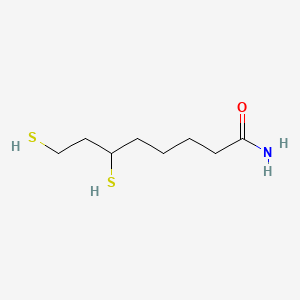| MeSH term | MeSH ID | Detail |
|---|---|---|
| Parkinsonian Disorders | D020734 | 20 associated lipids |
Dihydrolipoamide
Dihydrolipoamide is a lipid of Fatty Acyls (FA) class. Dihydrolipoamide is associated with abnormalities such as Wiskott-Aldrich Syndrome. The involved functions are known as Citric Acid Cycle, Electron Transport, NADH oxidation, Oxidation and Oxidants. Dihydrolipoamide often locates in Mitochondria, Mitochondrial matrix and Chloroplasts. The associated genes with Dihydrolipoamide are Mutant Proteins, Recombinant Proteins, mycothione reductase, Genes, Mitochondrial and alanylproline.
Cross Reference
Introduction
To understand associated biological information of Dihydrolipoamide, we collected biological information of abnormalities, associated pathways, cellular/molecular locations, biological functions, related genes/proteins, lipids and common seen animal/experimental models with organized paragraphs from literatures.
What diseases are associated with Dihydrolipoamide?
Dihydrolipoamide is suspected in and other diseases in descending order of the highest number of associated sentences.
Related references are mostly published in these journals:
| Disease | Cross reference | Weighted score | Related literature |
|---|
Possible diseases from mapped MeSH terms on references
We collected disease MeSH terms mapped to the references associated with Dihydrolipoamide
PubChem Associated disorders and diseases
What pathways are associated with Dihydrolipoamide
There are no associated biomedical information in the current reference collection.
PubChem Biomolecular Interactions and Pathways
Link to PubChem Biomolecular Interactions and PathwaysWhat cellular locations are associated with Dihydrolipoamide?
Visualization in cellular structure
Associated locations are in red color. Not associated locations are in black.
Related references are published most in these journals:
| Location | Cross reference | Weighted score | Related literatures |
|---|
What functions are associated with Dihydrolipoamide?
Related references are published most in these journals:
| Function | Cross reference | Weighted score | Related literatures |
|---|
What lipids are associated with Dihydrolipoamide?
There are no associated biomedical information in the current reference collection.
What genes are associated with Dihydrolipoamide?
Related references are published most in these journals:
| Gene | Cross reference | Weighted score | Related literatures |
|---|
What common seen animal models are associated with Dihydrolipoamide?
There are no associated biomedical information in the current reference collection.
NCBI Entrez Crosslinks
All references with Dihydrolipoamide
Download all related citations| Authors | Title | Published | Journal | PubMed Link |
|---|---|---|---|---|
| Suetsugu-Maki R et al. | A complement receptor C5a antagonist regulates epithelial to mesenchymal transition and crystallin expression after lens cataract surgery in mice. | 2011 | Mol. Vis. | pmid:21541266 |
| Vyas PM and Payne RM | TAT opens the door. | 2008 | Mol. Ther. | pmid:18362922 |
| Rapoport M et al. | TAT-mediated delivery of LAD restores pyruvate dehydrogenase complex activity in the mitochondria of patients with LAD deficiency. | 2008 | Mol. Ther. | pmid:18362926 |
| de Berardinis V et al. | A complete collection of single-gene deletion mutants of Acinetobacter baylyi ADP1. | 2008 | Mol. Syst. Biol. | pmid:18319726 |
| McMillan PJ et al. | The human malaria parasite Plasmodium falciparum possesses two distinct dihydrolipoamide dehydrogenases. | 2005 | Mol. Microbiol. | pmid:15612914 |
| Leach MD et al. | Molecular and proteomic analyses highlight the importance of ubiquitination for the stress resistance, metabolic adaptation, morphogenetic regulation and virulence of Candida albicans. | 2011 | Mol. Microbiol. | pmid:21269335 |
| Roldán A et al. | Lipoamide dehydrogenase is essential for both bloodstream and procyclic Trypanosoma brucei. | 2011 | Mol. Microbiol. | pmid:21631607 |
| Smith AW et al. | Characterization of the dihydrolipoamide dehydrogenase from Streptococcus pneumoniae and its role in pneumococcal infection. | 2002 | Mol. Microbiol. | pmid:11972781 |
| Boucher IW et al. | Structural and biochemical characterization of a mitochondrial peroxiredoxin from Plasmodium falciparum. | 2006 | Mol. Microbiol. | pmid:16879648 |
| Tian J et al. | Mycobacterium tuberculosis appears to lack alpha-ketoglutarate dehydrogenase and encodes pyruvate dehydrogenase in widely separated genes. | 2005 | Mol. Microbiol. | pmid:16045627 |
